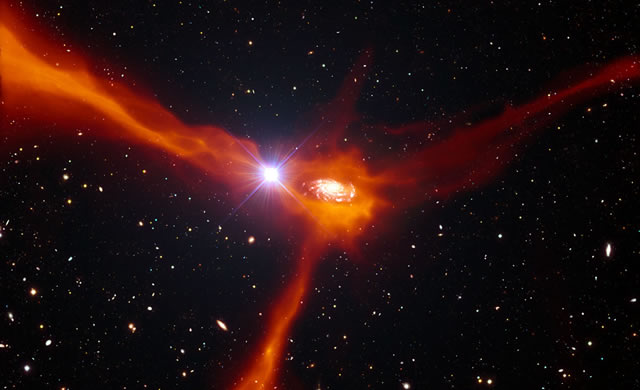
Alcuni astronomi, usando il VLT (Very Large Telescope) dell’ESO, hanno identificato una galassia lontana che sta avidamente nutrendosi del gas nelle vicinanze. Si vede il gas cadere verso la galassia, creando un flusso che alimenta la formazione stellare e al tempo stesso incrementa la rotazione della galassia. Questa è finora la miglior evidenza osservativa che conferma la teoria che le galassie inglobino e divorino il materiale circostante per crescere e formare stelle. I risultati saranno pubblicati nel numero del 5 luglio 2013 della rivista Science.
Gli astronomi hanno sempre sospettato che le galassie crescano attirando materia dai dintorni, ma questo processo si è dimostrato molto difficile da osservare direttamente. Ora il VLT (Very Large Telescope) dell’ESO è stato usato per studiare un raro allineamento tra una galassia distante e un quasar ancora più lontano – il nucleo luminosissimo di una galassia alimentato da un buco nero supermassiccio. La luce del quasar, prima di raggiungere la Terra, passa attraverso la materia che circonda la galassia, rendendo possibile studiare in dettaglio le proprietà del gas intorno alla galassia. Questi nuovi risultati offrono la miglior vista finora di una galassia mentre si nutre. “Questo tipo di allineamento è molto raro e ci ha permesso finora di effettuare osservazioni uniche”, spiega Nicolas Bouché del Research Institute in Astrophysics and Planetology (IRAP) di Tolosa, Francia, primo autore dell’articolo. “Abbiamo potuto usare il VLT (Very Large Telescope) dell’ESO per osservare sia la galassia stessa che il gas circostante. Ciò ci ha permesso di affrontare un nodo importante della teoria della formazione delle galassie: come fanno le galassie a crescere e alimentare la formazione stellare?”. Le galassie consumano rapidamente la loro riserva di gas per creare nuove stelle e perciò in qualche modo devono essere continuamente rifornite di nuovo gas per andare avanti. Gli astronomi sospettavano che la risposta a questo problema stesse nella raccolta di gas freddo dai dintorni, grazie all’attrazione gravitazionale della galassia. In questo scenario una galassia attira gas verso l’interno e questo poi si mette a girare intorno alla galassia, ruotando con essa prima di cadere. Anche se qualche prova di questo tipo di accrescimento era stata già osservata nelle galassie, il moto del gas e le altre sue proprietà non erano state ben studiate finora.
Fonte/Leggi tutto → ESO.org
Astronomers using ESO’s Very Large Telescope have spotted a distant galaxy hungrily snacking on nearby gas. Gas is seen to fall inwards towards the galaxy, creating a flow that both fuels star formation and drives the galaxy’s rotation. This is the best direct observational evidence so far supporting the theory that galaxies pull in and devour nearby material in order to grow and form stars. The results will appear in the 5 July 2013 issue of the journal Science.
Astronomers have always suspected that galaxies grow by pulling in material from their surroundings, but this process has proved very difficult to observe directly. Now ESO’s Very Large Telescope has been used to study a very rare alignment between a distant galaxy and an even more distant quasar — the extremely bright centre of a galaxy powered by a supermassive black hole. The light from the quasar passes through the material around the foreground galaxy before reaching Earth, making it possible to explore in detail the properties of the gas around the galaxy. These new results give the best view so far of a galaxy in the act of feeding. “This kind of alignment is very rare and it has allowed us to make unique observations,” explains Nicolas Bouché of the Research Institute in Astrophysics and Planetology (IRAP) in Toulouse, France, lead author of the new paper. “We were able to use ESO’s Very Large Telescope to peer at both the galaxy itself and its surrounding gas. This meant we could attack an important problem in galaxy formation: how do galaxies grow and feed star formation?” Galaxies quickly deplete their reservoirs of gas as they create new stars, and so must somehow be continuously replenished with fresh gas to keep going. Astronomers suspected that the answer to this problem lay in the collection of cool gas from the surroundings by the gravitational pull of the galaxy. In this scenario, a galaxy drags gas inwards, which then circles around the galaxy, rotating with it before falling in. Although some evidence of such accretion had been observed in galaxies before, the motion of the gas and its other properties had not been fully explored up to now.
Source/Continue reading → ESO.org





















